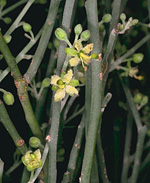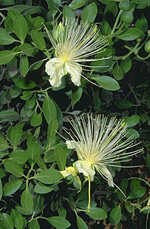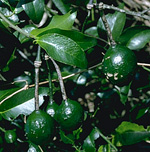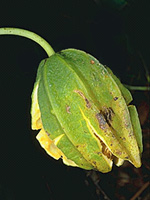 |
A medium-sized family mostly from warm, dry areas of the world especially
Africa. Most species of Capparaceae in Australia are tropical, found in
rain forests and monsoon forests, but some have become adapted to the
arid zone in areas with reliable groundwater. The family is absent from
temperate parts of souther Australia.
Characteristic features of the family Capparaceae in Australia include: - herbs, shrubs, climbers or trees, sometimes with spiny stipules, often with glandular hairs
- leaves alternate, simple, or palmately divided
- flowers 4-partite, the petals often clawed at the base
- stamens few to very numerous and prominent
- ovary superior, often on a long stalk (gynophore), developing into a long-stalked, often brightly-coloured, fleshy capsular fruit
Description
Evergreen trees or shrubs, or woody or herbaceous vines climbing by hooks, twining or scrambling stems, or annual or perennial terrestrial herbs. Leaves sometimes ±absent. Stems unarmed or with thorns or spines arising from the leaf axils. Vegetative reproduction absent or by ?root suckers. Internal secretions not obvious. Plants glabrous or with simple, dendritic or stellate, glandular or non-glandular, unicellular, uniseriate or ?multiseriate hairs. Leaves mostly present, rarely much reduced to entirely absent, alternate and spiral or distichous, or if herbs then the leaves cauline, all or mostly basal, or both basal and cauline, petiolate, subsessile or sessile; pulvinae ?absent. Stipules absent, or present, distinct and free from the petiole, scale-like or membranous or spine-like, falling off early or persistent; stipellae present or absent. Lamina simple or once compound, ternate or palmate, symmetric, filiform, acicular, subulate, linear, lanceolate, ovate, elliptic, oblanceolate, obovate or orbicular; base cuneate, attenuate, rounded or cordate; margins entire or dentate, ±flat, revolute or recurved; one-veined, or the venation palmate, with the midrib conspicuous, and the tertiary venation reticulate or not; surfaces not punctate; herbaceous or leathery. Male and female flowers occurring on separate plants, or with all the flowers bisexual. Inflorescences terminal or axillary, consisting of racemes, corymbs or solitary flowers. Bracts rarely present, herbaceous or scarious, falling off early. Pollination by insects and ?birds. Flowers odourless or fragrant; stalked. Floral disc present; nectaries absent or present on the disc. Perianth regular or irregular, of 2 dissimilar whorls, imbricate in bud. Calyx segments free or fused, with (2–) 4 sepals or lobes; calyx cup-shaped or tubular, herbaceous; base with spurs or pouches or without appendages. Corolla segments free, with 4 petals, alternating with the sepals or calyx lobes; corolla 2-lipped, sometimes with palate, white, cream, yellow, orange, pink, magenta or purple, without contrasting markings, membranous; claws present or absent; lobes ±entire or trifid, trilobed or more divided. Fertile stamens 1, or 3–numerous, alternating with the sepals or calyx lobes, free of the corolla, free of the ovary and style or at least partly fused with the ovary or style, distinct from each other or fused by their filaments into an open or closed tube, all ±equal. Anthers dorsifixed or basifixed, opening inwards by longitudinal slits; 2-celled. Ovary superior and stalked or rarely sessile. Carpels 2–6, fused; ovary with 1–3 locules. Style terminal, single and unbranched and the stigma capitate. Ovules 1–numerous per locule, stalked; placentation parietal. Fruit dry or fleshy, dehiscent or indehiscent, an amphisarcum, septicidal capsule or berry; the perianth on the maturing fruit deciduous or dry and persistent. Disseminule macro-surface featureless; micro-surface ±smooth, tuberculate, reticulate, rugose or finely striate, yellow, magenta, purple, violet, green, brown, grey or black, dull. Seeds 1–numerous per fruit. Aril present or absent. Cotyledons 2. Embryo curved.
(Note: this description has been generated from the coded data compiled for the key. Any errors in the key data will be reflected in the descriptions.)
A treatment of the family Capparaceae has been published in:
Flora of Australia 8: 207-231.
Australian genera of Capparaceae (as recognised for the Flora of Australia)
Apophyllum
Cadaba
Capparis
Cleome
Crateva

|
  |

Apophyllum anomalum (flowers)
Photo: M.Fagg © M.Fagg

Capparis mitchellii (flowers)
Photo: B.Allwright © B.Allwright

Capparis nobilis (fruits)
Photo: M.Fagg © ANBG

Capparis spinosa var. nummularia (fruit)
Photo: B.Allwright © B.Allwright

|
 |
|